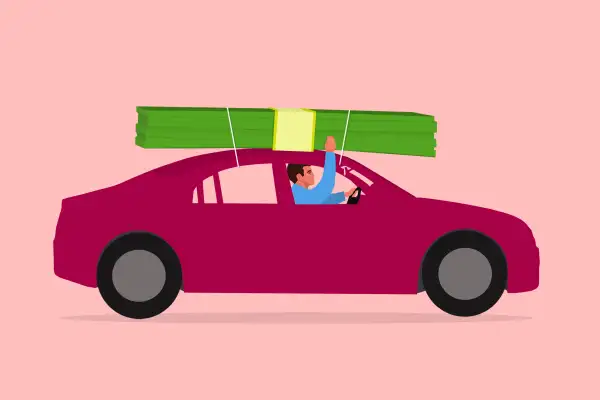How to Get a Car Loan: A Step-by-Step Guide

If you’re planning to buy a vehicle, the odds are you’ll be doing so with help from a car loan — since more than half of all cars are bought this way.
With auto loan interest rates at the highest level since 2007, it’s important to search around for a competitive rate.
A lot of car buyers start their shopping by selecting the car they want, and then initiate steps to finance it. That’s not the best order of play, according to car-buying experts. If you research (and even secure) your loan first, you’ll be better informed about how much you can afford to spend before you begin to kick tires and take test drives.
Used-car buyers can buy a vehicle with a car loan, but typically only if it’s from a car dealer franchised by a major car manufacturer. Private party auto loans are an option, but they’re not offered by many lenders. The only other financing option for a private-sale used car purchase is a personal loan — which will have a higher interest rate than a car loan.
This guide runs down the steps to get a car loan, including the best ways to shop for the loan and how to narrow down your choice of lenders.
Table of contents:
- Step 1: Check your credit score
- Step 2: Shop around
- Step 3: Determine your budget
- Step 4: Consider different types of lenders
- Step 5: Get pre-approved
- Step 6: Shop for cars with your pre-approval in hand
- Pros and cons of getting a car loan
- How to get a car loan if you have bad credit
- How to get a car loan FAQs
Step 1: Check your credit score
Verifying your credit score allows you to start shopping for a car loan armed with the best idea of whether you’ll be approved for a loan and if so, the amount, interest rate and loan term you might receive. The better your score, the better those terms if you take out a loan. (Our advice is mostly aimed at those with solid credit scores. If you have poor credit, see the section at the end of this guide.)
Checking your score has other benefits, apart from preparing to get a car loan. It also allows you to validate the information in your credit reports, and to ensure that no errors or other issues are unfairly hurting your credit history or lowering your credit score. The good news is that you get to see, for free, what’s on your credit rap sheet. Through at least the end of 2023, you can view one free report per bureau per week by going to annualcreditreport.com and filling out a form.
Your credit score isn't the only factor lenders consider during the application process, according to Experian, one of the credit bureaus that generates those scores. They'll also look at your credit report, your debt-to-income ratio (your monthly debt payments relative to your gross monthly income), your employment history and other factors.
But a score that’s at least good — defined as 670 or more by FICO — makes it more likely you’ll be approved for a car loan, and at the best terms. If it's in the fair range, Experian says, you'll likely qualify as well, though you may have to settle for an offer that carries higher interest charges and fees or requires a relatively high down payment.
Step 2: Shop around
To save money on your car payments, you shouldn’t just shop around for the best priced vehicle — you’ll also want to comparison shop when it comes to your loan options.
Consider different types of auto lenders. Take the time to get multiple loan offers from banks, credit unions and online lenders. Then you can compare the terms of these offers with what the dealership presents to you, and you might even be able to negotiate from there. Don’t make the mistake of committing to the first loan offer you receive, since it might not come with the best rate that’s out there for you.
Step 3: Determine your budget
Early in the car shopping process, review your finances to establish how much you’re able to put toward a down payment as well as the maximum amount you can afford to pay each month. Most lenders’ websites will have auto loan calculators that you can use to get an estimate of your monthly payments, factoring in interest on top of the vehicle price.
It may be possible to stretch your budget by opting for a longer loan term (say, 72 months), which will reduce your monthly payments. Keep in mind, though, that you'll likely end up with a higher loan rate if you go that route.
Beyond the question of what you can afford, it’s also crucial to understand the maximum amount you’re able to borrow. This is where pre-qualification and pre-approval enter the picture. But keep in mind that you shouldn’t plan to put the entire principal of a loan toward the vehicle price, since you’ll also need to pay taxes and other fees on your purchase.
Auto-buying site Edmunds suggests that, if you’ve been approved for a $30,000 loan, plan to reserve several thousand dollars of the amount to cover those extra expenses. You needn’t spend the money on any particular car or at any particular dealership. Instead, Edmunds suggests considering the pre-approval figure as a sort of "blank check" that isn't limited to a certain car or dealer, and that you can spend up to its allowed maximum.
Step 4: Consider different types of lenders
You’ll invariably be pitched a car loan by the dealership, assuming that’s where you buy the car. New car loans offered at dealerships are often subsidized by the manufacturer, and so can be a good option for many who have good credit, according to Consumer Reports.
But don’t make the dealer the only place you shop for a loan. You may find better terms elsewhere that could lead to lower monthly payments. You you might gain insights from your research that better arms you to negotiate with the dealer over the car’s cost and the terms of its auto financing.
Your bank or credit union is another easy shopping option, especially if you already have a beneficial personal relationship there. If you’re not a credit union member, consider joining one since car loans from these institutions may offer lower rates and fees than banks (This federal site can help you locate credit unions). You can also pitch your car-loan business to online lenders, which may also offer better loan rates than your bank. Sites such as Autopay allow you to gather multiple loan quotes with a single application.
However, Consumer Reports warns that these applications may prompt an annoying flurry of phone calls or emails, and the resulting loan may have higher fees than some other options. Ask about different terms and down payments and see how they affect your monthly payments. You might also want to ask about prepayment: if you get a windfall, can you opt to pay down the loan amount? With what penalties, if any?
Step 5: Get pre-approved for the loan
With your shopping research done, it's time to get a loan commitment — or even a number of them. You may already be pre-qualified, but the next step is pre-approval.
Pre-approval vs. pre-qualification
As you shop around, prospective lenders will have given you what are known as loan pre-qualifications for your loan amount. These signal the likelihood that they will give you a loan, along with its probable principal and rate. However, a “prequal” falls short of being a precise, binding quote. Such specificity requires pre-approval, which is a more involved process.
Application requirements
While pre-qualifications require only estimated figures — of your annual income, monthly housing costs, and savings, as examples — pre-approval demands submitting such documents as tax returns, pay stubs and bank statements. It’s usually not necessary to have a driver’s license, but some form of identification will be needed.
A formal credit check is also required. Where pre-qualifications involve only an invisible “soft” inquiry about your credit score, the “hard pull” of the pre-approval process will show up on your credit history. Every hard pull shaves a few points from your credit score, as a rule. However, with auto loans and mortgages, multiple inquiries within a given period of time (typically 14 to 45 days) are generally counted as just one inquiry, according to credit bureau Equifax. That fact means you can seek pre-approvals from several lenders — to compare their offers — with little or no risk of accumulating damage to your credit score. The main variable is the time you’re prepared to devote to submitting the necessary documents to each lender.
Step 6: Shop for cars with your pre-approval in hand
Armed with your pre-approval, you’re now ready to visit multiple dealerships and test-drive as many cars as you want before making a decision to buy. (Some lenders, though, have a list of approved car dealers, so make sure you verify that the dealerships at which you're shopping are on it.)
If you’re shopping for a used car, additional restrictions will apply, beyond the need to buy from a franchised car dealership rather than an individual or independent car lot if you want a traditional loan. The maximum amount you can borrow may be capped, along with the age and mileage of the car.
Capital One, for example, says borrowers can only finance a used vehicle that is no more than 10 years old and has 120,000 miles or less on its odometer. With both new and used cars, your pre-approval can be used as a bargaining tool during negotiations with the dealer. For example, if the dealer is asking more than your pre-approved amount, consider using that gap as leverage to get a better price.
If the pre-approval offers better terms than the dealer financing, consider offering to take a loan through the dealer in exchange for a lower purchase price or free vehicle add-ons, such as accessories for a new car or a longer warranty for a used one. Once you've found the right car, and settled on a price, you hand over your pre-approval document. The dealer will then get in touch with your lender to arrange payment.
Pros and cons of getting a car loan
For most car shoppers, getting a car loan is the only way they can fund the purchase — after all, the average new car costs nearly $50,000. Car loans are great because they enable many Americans to buy nicer vehicles than they could otherwise afford were they paying entirely in cash.
That said, you can end up paying a lot in interest when you take out a car loan, especially when loan rates are high. Borrowers with low credit scores and those who take out long loans without putting much if any money down end up spending the most on interest. Other risks with car loans include the consequences if you miss payments, along with the possibility of being upside down on your loan due to the vehicle’s depreciation.
But if you manage your car loan responsibly, your on-time payment history and additional mix of credit could actually be good for your credit score and your financial health.
How to get a car loan if you have bad credit
It’s still possible to get a car loan if you have a checkered credit history, but you’ll naturally pay more in interest than if you had a higher credit score. Your list of likely lenders will also be shorter, and you may need to take steps that more creditworthy consumers can forego. (These tips will also be useful to those who lack any credit at all in the U.S., such as recent immigrants.)
There’s little to no hope of qualifying for the low- or no-interest loan offers touted in auto ads if your credit record is problematic. In today’s high-interest-rate environment, car buyers with poor or fair credit can expect an annual percentage rate of between 10% and 20%, according to Experian. Banks are a less likely source of a car loan if your credit is damaged, since they are more conservative with risk than some other lenders. Credit unions can be more lenient about the financial history of those they lend to, and their rates can be much lower than for some other lending alternatives for those with problematic credit scores.
Those other options include dealers, often independents, who specify that they cater to buyers with bad credit. As Equifax says, such “buy-here-pay-here” sellers potentially profit from both the car sale and the loan, and so are often more flexible with their credit requirements. The agency warns, though, that such dealers may charge high interest, even compared with other lenders, to the credit-damaged, and they may require that monthly loan payments be made in person at the lot.
Two other steps will increase the odds that those with poor credit will receive a car loan, and be able to manage it after they do so.
The first step is to seek a co-signer for the loan who themselves has a credit record that’s good or better. Keep in mind, though, that a co-signed loan broadens the impact of missed payments or a default beyond simply your own finances and credit record; your co-signer will be on the hook for those, and their own payment history and credit score will be damaged by any missteps you make.
The other step is to amass the largest downpayment you can. That will not only reduce the amount you need to borrow, and increase your odds of loan approval, but reduce your interest payments and the overall financial burden of the purchase.
Manage your car loan responsibly
Keep in mind that with a car bought with a loan, you don't only own a new vehicle but you also have a new financial obligation. Be careful, then, to make car payments on time. And if you will be late in a particular month, it’s best to contact the lender in advance, explaining the reason.
How to get a car loan FAQs
What credit score do I need to get a car loan?
How much should I expect to pay for a car loan?
What documents do I need to apply for a car loan?
More on Car Insurance
Money’s Top Picks
Car Insurance Reviews Learn More |

